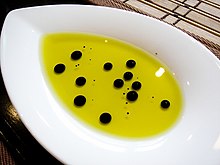Phase separation



Phase separation is the creation of two distinct phases from a single homogeneous mixture.[1] The most common type of phase separation is between two immiscible liquids such as oil and water. Colloids are formed by phase separation, though not all phase separation forms colloids - for example oil and water can form separated layers under gravity rather than remaining as microscopic droplets in suspension.
See also
References
- ^ Nic M, Jirat J, Kosata B (1997). "Phase separation". In McNaught AD, Wilkinson A, Jenkins A (eds.). IUPAC Compendium of Chemical Terminology (the "Gold Book") (2nd ed.). Oxford: Blackwell Scientific Publications. doi:10.1351/goldbook.P04534. ISBN 0-9678550-9-8.
Further reading
- Khabibullaev, Pulat K.; Saidov, Abdulla (April 2013). Phase Separation in Soft Matter Physics: Micellar Solutions, Microemulsions, Critical Phenomena. Berlin Heidelberg: Springer. ISBN 978-3-662-09278-1.
{{cite book}}: Unknown parameter|name-list-format=ignored (|name-list-style=suggested) (help)
